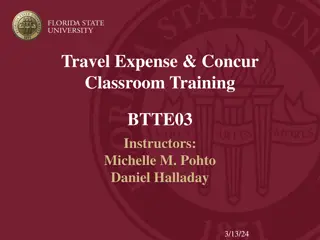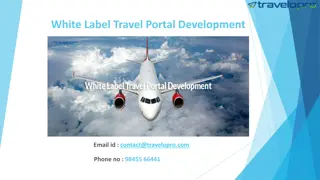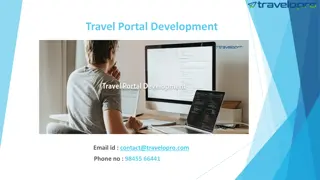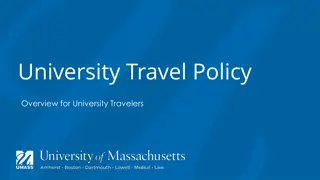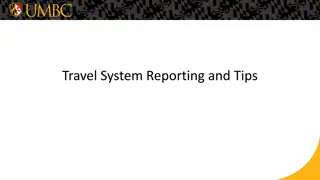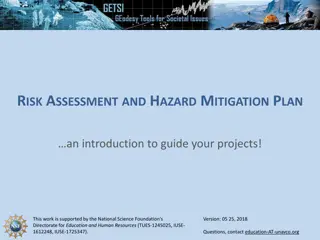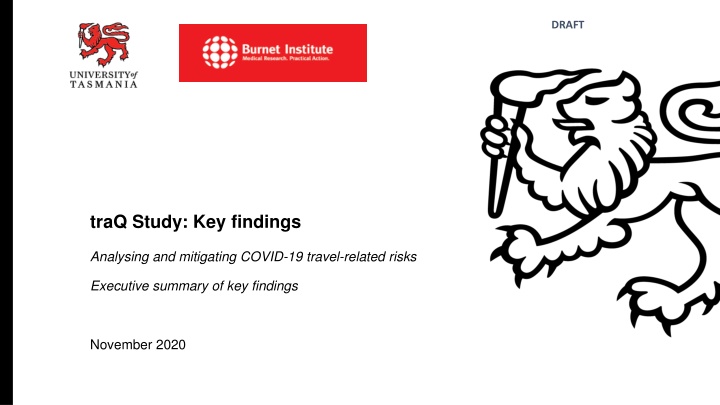
Mitigating COVID-19 Travel Risks: Key Findings and Analysis
"Explore the findings of a study analyzing COVID-19 travel risks and strategies to mitigate them, focusing on international travel to Australia. The Transparent Risk Assessment of Quarantine model evaluates risks associated with travel, effectiveness of mitigation strategies, and economic benefits. Discover the elements of the traQ model, estimation of COVID risk in the country of origin, and more. Access the full report for in-depth insights."
Download Presentation

Please find below an Image/Link to download the presentation.
The content on the website is provided AS IS for your information and personal use only. It may not be sold, licensed, or shared on other websites without obtaining consent from the author. If you encounter any issues during the download, it is possible that the publisher has removed the file from their server.
You are allowed to download the files provided on this website for personal or commercial use, subject to the condition that they are used lawfully. All files are the property of their respective owners.
The content on the website is provided AS IS for your information and personal use only. It may not be sold, licensed, or shared on other websites without obtaining consent from the author.
E N D
Presentation Transcript
DRAFT traQ Study: Key findings Analysing and mitigating COVID-19 travel-related risks Executive summary of key findings November 2020
traQ project aims The project provides sophisticated analysis to assess the COVID risks and economic benefits associated with resuming international travel to Australia The Transparent Risk Assessment of Quarantine (traQ) model was developed by the Burnet Institute in partnership with the University of Tasmania and Monash University. The project has three broad aims: 1) To assess the COVID-19 risk associated with the resumption of international and interstate travel for a range of jurisdictions and scenarios 2) To assess the effectiveness of different strategies (combinations of quarantine and PCR testing) used to mitigate COVID-19 related travel risks 3) To provide a preliminary COVID risk versus economic benefit analysis to inform government strategy and policy in relation to the resumption of both interstate and international travel Note: This synopsis has been prepared by the University of Tasmania and the full report is available at https://www.burnet.edu.au/system/asset/file/4348/Final_Report_9November2020_Final.pdf
1. Elements of the traQ Model The TraQ analysis quantifies and models COVID risk associated with 4 elements/phases of international travel The analysis identifies evidence-based risk mitigation strategies based on the COVID risk associated for specific travel cohorts Based on 2019 data, we estimate the value of 5 types of travel to the Australian economy and present preliminary economic benefit versus risk analysis
Estimating COVID risk in country of origin The model uses a sophisticated method to conservatively estimate the COVID-19 risk associated with arrivals from specific countries at a particular point in time It is not possible to accurately predict the point-in- time prevalence of COVID-19 in a given community or among a specific cohort of arriving travellers The traQ model makes conservative estimates of prevalence based on: Observed 10-day case incidence in the country of origin Adjusting the 10-day case incidence using the under- ascertainment method developed by Russell et al Further adjusting the incidence based on the higher observed prevalence of COVID-19 detected in arrivals to Australia participating in managed quarantine For countries with inadequate testing or inadequate data, reclassifying two risk classifications higher (the latter step is for the strict risk assessment only) o o o o This method informs a five level risk classification framework. Jurisdictions move between classifications subject to latest COVID data (most European countries are now in the high risk category)
Effectiveness of quarantine and testing in mitigating COVID-19 travel risk Quarantine is the only effective way to significantly reduce the risk of importing COVID-19 from high risk jurisdictions. The focus should be on low volume, high value travel PCR testing is only accurate 4/5 days after infection Testing on arrival by itself only reduces infection risk by 24% Effective quarantine is the foundation of any risk mitigation strategy, testing merely complements this 14 day quarantine with enhanced testing remains the gold standard for high risk arrivals (reduces risk by 99%) There is a clear trade off for shortening quarantine which may be an option for lower risk arrivals
The risks and benefits of resuming travel for key cohorts The model highlights the need to focus on low volume, high value travel given prevailing COVID risks Explanatory notes Explanatory notes International student and international travel risks are calculated using two different sets of assumptions: strict risk assessment: strict risk assessment: includes a multiplier for higher prevalence among international arrivals & higher data quality threshold to secure low or very low risk rating standard risks assessment: standard risks assessment: based on estimates of prevalence alone International tourism is limited to very low risk jurisdictions (e.g. New Zealand) with pre-travel and on arrival testing Domestic tourism assumes interstate travel with no testing between very low risk states and territories All other cohorts are subject to risk-based quarantine and testing Covid risk assessment low risk moderate risk high risk very high risk
Key findings and policy implications 1. The COVID risk versus economic benefit analysis presented in the report suggests the selective resumption of low volume, high value international travel supported by evidence-based quarantine and testing regimes. Priorities for international travel should be FIFO workers, agricultural workers, international students, permanent migrants and returning Australians The resumption of international student travel to Australia would make the greatest contribution to the national economy (up to $4bn pa). Given the challenges of scaling effective quarantine procedures international student arrivals are unlikely to return to their 2019 levels so long as the offshore COVID risk remains high It will be difficult to resume mass international travel while the global prevalence of COVID remains high. However, selective international travel with very-low risk jurisdictions (travel bubbles) may pose an acceptable risk 2. Large scale/volume international travel will continue to pose a significant risk to countries which have effectively supressed COVID-19 (such as Australia) for the foreseeable future 3. Given the scale of interstate travel mass quarantining and testing is not a viable option. The resumption of domestic travel depends on the effective suppression of COIVD-19 (which has almost been achieved as of early November 2020)




